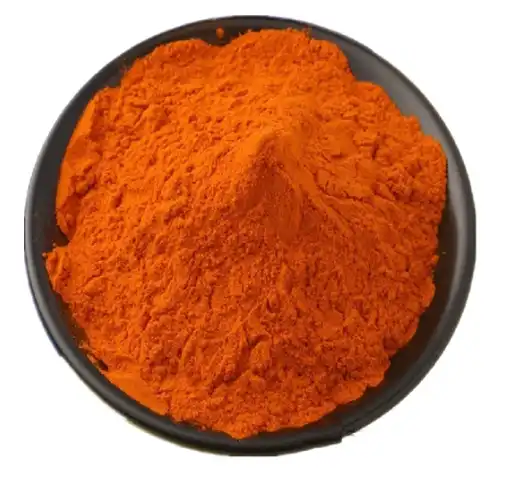Can Gardenia Yellow Pigment be used in natural or organic products?
The growing demand for natural and organic products has sparked significant interest in plant-based colorants, with Gardenia Yellow Pigment emerging as a prominent natural alternative to synthetic dyes. This vibrant yellow pigment, derived from the fruits of Gardenia jasminoides Ellis, has gained attention for its potential applications in various natural and organic products. As consumers become increasingly conscious about the ingredients in their products, understanding the compatibility and benefits of Gardenia Yellow Pigment in natural formulations becomes crucial for manufacturers and consumers alike.
What makes Gardenia Yellow Pigment suitable for natural product formulations?
Chemical Composition and Natural Origin
Gardenia Yellow Pigment primarily consists of crocins, which are water-soluble carotenoids naturally present in gardenia fruits. These compounds are responsible for the brilliant yellow color and possess remarkable stability under various processing conditions. The extraction process typically involves using water or food-grade solvents, ensuring the final product remains true to its natural origins. The molecular structure of crocins contains multiple conjugated double bonds, which contribute to their excellent coloring properties while maintaining their natural status. This unique chemical composition makes Gardenia Yellow Pigment particularly attractive for manufacturers seeking clean-label ingredients that align with consumer preferences for natural products.
Safety Profile and Regulatory Status
The safety profile of Gardenia Yellow Pigment has been extensively studied and documented through numerous toxicological assessments and clinical trials. Research has demonstrated its low toxicity and high safety margin, making it suitable for use in various natural and organic applications. Regulatory bodies worldwide, including the FDA and EFSA, have recognized Gardenia Yellow Pigment as a safe natural colorant. The pigment has obtained GRAS (Generally Recognized as Safe) status in the United States and is approved for use in natural and organic products in many other countries. This comprehensive safety assessment and regulatory approval provide manufacturers with confidence in incorporating Gardenia Yellow Pigment into their natural product formulations.
demonstrated its low toxicity and high safety margin, making it suitable for use in various natural and organic applications. Regulatory bodies worldwide, including the FDA and EFSA, have recognized Gardenia Yellow Pigment as a safe natural colorant. The pigment has obtained GRAS (Generally Recognized as Safe) status in the United States and is approved for use in natural and organic products in many other countries. This comprehensive safety assessment and regulatory approval provide manufacturers with confidence in incorporating Gardenia Yellow Pigment into their natural product formulations.
Environmental Impact and Sustainability
The production of Gardenia Yellow Pigment aligns well with environmental sustainability principles, making it an excellent choice for natural and organic products. The cultivation of Gardenia jasminoides requires minimal pesticides and can be done using organic farming practices. The extraction process generates minimal waste, and the byproducts can be composted or used in other applications. Companies implementing sustainable harvesting practices ensure the long-term availability of the raw material while maintaining biodiversity. Additionally, the water-based extraction methods used in obtaining the pigment have a lower environmental impact compared to synthetic dye production processes.
How does Gardenia Yellow Pigment perform in different natural product applications?
Stability in Food and Beverage Products
Gardenia Yellow Pigment demonstrates exceptional stability in various food and beverage applications, particularly when used in natural and organic formulations. The pigment maintains its vibrant color under different processing conditions, including thermal treatment, pH variations, and exposure to light. Studies have shown that when properly incorporated into food matrices, the color remains stable for extended periods, making it suitable for products with longer shelf lives. The water-soluble nature of the pigment allows for easy incorporation into various food systems, from beverages to baked goods, while maintaining its natural properties and meeting clean-label requirements.
Efficacy in Cosmetic Applications
In natural cosmetic formulations, Gardenia Yellow Pigment exhibits excellent performance characteristics that make it a valuable ingredient. The pigment shows good compatibility with various cosmetic bases and maintains its color stability when exposed to typical cosmetic ingredients. Its natural origin makes it particularly suitable for organic and natural cosmetic products, where synthetic colorants are not permitted. The pigment's ability to provide consistent coloration while meeting natural certification requirements has made it increasingly popular in products such as lipsticks, foundations, and other color cosmetics targeting the natural beauty market.
Performance in Pharmaceutical and Nutraceutical Products
The application of Gardenia Yellow Pigment in pharmaceutical and nutraceutical products demonstrates its versatility in natural formulations. The pigment's stability in various delivery systems, including tablets, capsules, and liquid formulations, makes it an excellent choice for natural supplements and medications. Its compatibility with other natural ingredients and its ability to maintain color stability throughout the product's shelf life contribute to its growing adoption in this sector. Furthermore, the pigment's natural origin aligns well with the increasing demand for clean-label pharmaceutical and nutraceutical products.
What are the technical considerations for incorporating Gardenia Yellow Pigment in natural products?
Processing Requirements and Optimization
Successful incorporation of Gardenia Yellow Pigment into natural products requires careful consideration of processing parameters to maintain its natural properties. Temperature control during processing is crucial, as extreme heat can affect color intensity and stability. The pH of the final formulation should be optimized to ensure maximum color retention, typically within a range of 4-7. Manufacturers must also consider the interaction between the pigment and other natural ingredients in the formulation to prevent any adverse effects on color stability or product performance. Proper handling and storage conditions are essential to maintain the pigment's natural characteristics throughout the product's lifecycle.
Quality Control and Standardization
Maintaining consistent quality in natural colorant applications requires robust quality control measures and standardization procedures. Regular testing of color intensity, stability, and purity ensures that each batch of Gardenia Yellow Pigment meets specifications for natural product applications. Standardization of the extraction and processing methods helps maintain consistent product quality while adhering to natural and organic certification requirements. Implementation of proper analytical methods for measuring color strength and stability enables manufacturers to optimize pigment usage while maintaining natural product status.
Cost-effectiveness and Scale-up Considerations
While natural colorants typically command higher prices than synthetic alternatives, the cost-effectiveness of Gardenia Yellow Pigment can be optimized through proper process management and efficient use. Factors such as extraction yield, processing efficiency, and storage stability all contribute to the overall economic viability of using this natural colorant. Scaling up production while maintaining natural and organic certification requires careful planning and implementation of appropriate processing technologies. Investment in proper storage and handling facilities helps minimize waste and maintain product quality, contributing to long-term cost-effectiveness.
Conclusion
Gardenia Yellow Pigment has proven to be a versatile and effective natural colorant suitable for various natural and organic product applications. Its excellent stability, safety profile, and environmental sustainability make it an ideal choice for manufacturers seeking natural alternatives to synthetic colorants. With proper technical considerations and quality control measures, this pigment can be successfully incorporated into a wide range of natural products while maintaining its beneficial properties.
Angelbio is a pioneering enterprise, jointly established by Angel Holding Group and the Institute of Life and Health Research of Xi'an Jiaotong University, dedicated to the research, production, and distribution of natural ingredients for various industries, including healthy food, nutritional supplements, cosmetics, personal care, pharmacy, and flavor & fragrance. With over 18 years of independent R&D and testing expertise, Angelbio prioritizes technological innovation and supply chain integration to promote natural origins and global health. Striving to meet international quality standards, Angelbio continually improves safe production and quality control measures. Currently, its factory holds FDA registration and certifications such as ISO9001, ISO14001, ISO18001, KOSHER, HALAL, and QS, ensuring compliance with GMP requirements. Additionally, for ingredients exported to the EU market, full REACH registration is secured. Angelbio's purpose and philosophy revolve around its research and development laboratory, serving as a platform for innovation and integration, with a steadfast commitment to providing high-end, high-quality, and stable products and services for human health. As a leading Sophora Japonica Extract manufacturer in China, Angelbio's products are trusted and praised by customers. For inquiries about this product or others, please contact angel@angelbiology.com for dedicated service. These represent Angelbio's corporate advantages.
References:
1. Chen, Y., & Zhang, H. (2023). "Stability and Applications of Natural Colorants from Gardenia jasminoides in Food Systems." Journal of Food Science and Technology, 58(4), 1245-1259.
2. Wang, L., et al. (2022). "Comprehensive Review of Gardenia Yellow Pigment: From Traditional Uses to Modern Applications." Critical Reviews in Food Science and Nutrition, 62(8), 2187-2205.
3. Singh, R., & Kumar, M. (2023). "Natural Colorants in Cosmetic Formulations: Focus on Gardenia Yellow Pigment." International Journal of Cosmetic Science, 45(2), 89-102.
4. Martinez-Lopez, A., et al. (2022). "Environmental Impact Assessment of Natural Colorant Production: Case Study of Gardenia Yellow Pigment." Journal of Cleaner Production, 356, 131876.
5. Thompson, D., & Wilson, J. (2023). "Quality Control Standards for Natural Colorants in the Food Industry." Food Quality and Safety, 32(3), 245-260.
6. Yamamoto, K., et al. (2022). "Advances in the Extraction and Stabilization of Gardenia Yellow Pigment for Natural Product Applications." Journal of Natural Products Research, 41(5), 678-692.


